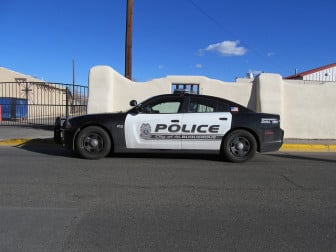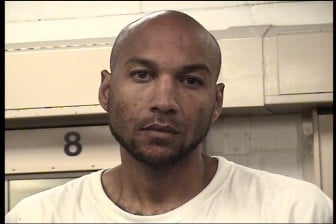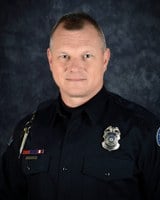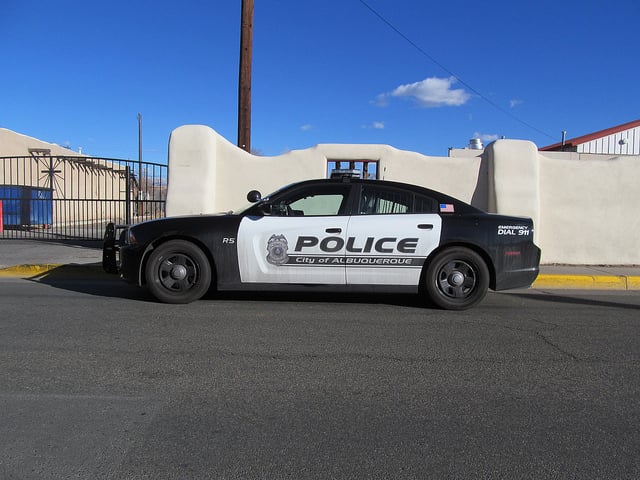 On Sept. 19, Albuquerque Police Detective Byron “Trey” Economidy spied a man on a scooter motoring northbound through the middle of town on Wyoming Boulevard.
On Sept. 19, Albuquerque Police Detective Byron “Trey” Economidy spied a man on a scooter motoring northbound through the middle of town on Wyoming Boulevard.
Given the clues — no keys, a “punched” ignition — Economidy suspected a stolen vehicle and pulled over the driver, a man with “very distinctive tattoos” later identified as Davon Lymon.
What happened next, detailed in Economidy’s police report and made public now for the first time, bears a chilling resemblance to a traffic stop nearly five weeks later.
On Oct. 21, APD officer Daniel Webster stopped Lymon on a motorcycle with a stolen license plate. Authorities say that stop ended when Lymon fatally shot Webster.
The outcome was different for Economidy, an officer with an uneven past at APD who once described his job on Facebook as “human waste disposal.”
His encounter — the second of three times officers and Lymon crossed paths in the weeks before Webster’s death — and what followed raise fresh questions about law enforcement’s dealings with the previously convicted killer and their efforts to get him off the streets.
Economidy’s report offers a window into a few minutes of high-stress police work.
During the stop, Economidy took a knife from Lymon and asked whether he had any other weapons. Lymon offered to show him, the police report says. Economidy ordered him to show his hands instead.
After going to his knees, Lymon “pretended he was having an asthma attack” and asked to retrieve an inhaler from his pocket. Economidy said no, then called for backup. Lymon rose to his feet, then bolted.
Economidy chased Lymon and watched him drop a “loaded firearms magazine.” He feared an ambush, according to the report, and slowed his pursuit.
Lymon disappeared into an apartment complex. Ultimately, he slipped away from Economidy and the other officers who had arrived on scene.
Later, Economidy sent his body camera video of the encounter to an APD Gang Unit sergeant, hoping to figure out whom he had stopped, according to the report. Working from images of his face and tattoos, the sergeant “immediately” identified Lymon.
Economidy’s report does not say whether the gang sergeant followed up. It is not clear, for example, whether the sergeant sent out a department-wide officer safety bulletin or shared information about Lymon with other agencies.
The scooter wasn’t reported stolen, but police do not appear to have issued an arrest warrant for Lymon for fleeing from Economidy or for possession of a firearm magazine by a felon.
In a text message, Economidy declined to comment and directed New Mexico In Depth to the department’s communications staff.
NMID sent several emails and left multiple voicemails beginning on Friday for spokeswoman Celina Espinoza and officer Tanner Tixier, who also handles media inquiries for the department. Neither of them responded to detailed questions, including what, if anything, the gang sergeant did after receiving the video from Economidy.
NMID obtained Economidy’s police report by searching Lymon’s name for a specific time period in the APD records system. Economidy’s name is not listed in the report, but his APD identification number is. NMID confirmed that Economidy’s report was written and submitted on the same day he stopped Lymon.
Questions, new and old, remain
The Sept. 19 encounter raises questions about the way information flows within APD — and between the department and other agencies.
Eight days before Lymon eluded Economidy, undercover agents from the federal bureau of Alcohol Tobacco Firearms and Explosives (ATF) purchased heroin from him, according to a motion filed last month in federal court.

Davon Lymon
Agents bought more heroin — and a handgun — from Lymon 13 days after the traffic stop on the scooter. The purchases totaled $6,500, court records show.
But the agents did not arrest Lymon, and 19 days after the second alleged purchase, Webster was fatally wounded.
The justice system was aware of Lymon long before his encounters with law enforcement last year.
He was released from prison in 2011 after serving 10 years on a manslaughter charge for killing the grandson of Blake’s Lotaburger founder Blake Chanslor. Lymon picked up an armed robbery charge in Española after his release; it was later dismissed. He also was facing the possibility of new state charges for beating a man outside an Albuquerque strip club in December 2014.
Taken together, the ATF purchases and the APD traffic stop in which Economidy said he shared video with the gang sergeant mean that two law enforcement agencies had Lymon within their grasp three times in the six weeks before he allegedly shot Webster.
He had a violent past. They had a growing body of evidence that he was still committing crimes — and capable of more violence.
Yet, Lymon remained free.
Now, he faces multiple federal charges of being a felon in possession of a firearm and distribution of narcotics. Lymon is in federal custody at the Sandoval County Detention Center.
He has not been charged with Webster’s death. That case is expected to proceed in state court.
Similarities to the Webster traffic stop

Officer Daniel Webster
Webster’s alleged fatal encounter with Lymon shares similarities with Economidy’s experience.
Authorities have said Webster stopped Lymon in a Walgreen’s parking lot near Central Avenue and Eubank Boulevard because the license plate on the motorcycle he was driving came back stolen. Econmidy suspected the same thing about the scooter, although a records check later showed it had not been reported stolen.
During the stop, Webster snapped a handcuff around Lymon’s left wrist, police have said. Lymon complained of an injury to his right shoulder. Nearly five weeks earlier in his run-in with Economidy, it was an “asthma attack.”
Economidy ordered Lymon to show his hands several times. In Webster’s case, he tried to handcuff Lymon to the motorcycle’s handlebars. That’s when Lymon pulled out a handgun and opened fire, authorities say. Several shots hit Webster, including in his face and chin.
APD tactical officers arrested Lymon hours later. They said the handcuffs were still secured on his left wrist.
Webster died days later at University of New Mexico Hospital.
Among the unanswered questions is how much he knew about the man who allegedly shot him at the time of the traffic stop.
A rallying point in a policy debate
In the months since his death, top officials including Albuquerque Mayor Richard Berry and Gov. Susana Martinez have held up the Webster shooting as an example of how the state’s lax laws and judges allow dangerous criminals to remain on the streets.
They have used the shooting as a rallying point in their push for an expanded three-strikes law, adding police officers to New Mexico’s hate crimes statute and other measures aimed at blunting violent crimes committed by repeat offenders.
But Lymon’s three run-ins with law enforcement agents in September and October cloud that narrative. Absent from the discussion have been the way undercover narcotics operations are conducted and the way information is shared within and among agencies.
Federal and local law enforcement agencies, meanwhile, remain tight-lipped about the incidents.
For instance, ATF often partners with local law enforcement agencies to conduct investigations through task forces in Albuquerque and elsewhere. It is not clear whether ATF used task force officers in the operation that led to the alleged heroin purchases in September and October 2015.
The Bernalillo County Sheriff’s Office has said deputies were not involved. But for more than two weeks, Albuquerque police have repeatedly refused to say whether its officers were involved.
The ATF and the U.S. Attorney’s Office also have refused to provide additional information about the operation, including why Lymon was not arrested after either of the alleged undercover purchases.
Lymon’s alleged sales to undercover agents were not even publicly known until his defense team cited them in a court motion filed on Jan. 29.
The defense lawyers initially said Albuquerque police officers made the purchases. Later, the U.S. Attorney’s Office issued a statement saying ATF conducted the undercover operation that targeted Lymon, and that APD did “not have a role in developing the investigative strategy” or in “supervising” the investigation. It’s unclear what, if anything, APD knew about the undercover operation.
After the U.S. Attorney’s Office released its statement, the defense lawyers, Kari Converse and Marc Robert, amended their court motion to say that, indeed, ATF agents made the alleged gun and heroin purchases. Robert told NMID last week that he could not discuss the case beyond what’s in the court motion, for now.

Excellent reporting!